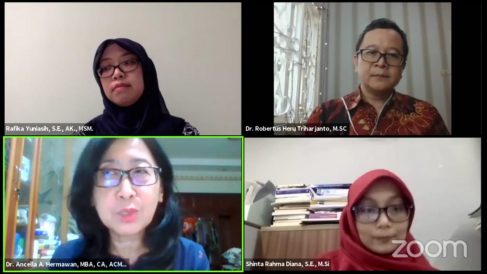FEB UI and LAPAN Hold 1st Toward SINASKPA V Webinar Series, “Space Economy”
Nino Eka Putra ~ FEB UI Public Relations Officer
DEPOK – 09/07/2020 The Faculty of Economics and Business, Universitas Indonesia (FEB UI), in collaboration with the National Institute of Aeronautics and Space (LAPAN), held the first SINASKPA V webinar series entitled Space Economy, Thursday (9/7/2020).
Speakers at the webinar were Dr. Robertus Heru Triharjanto, M.SC., Head of LAPAN’s Aeronautics and Space Policy Study Center (KKPA), and Shinta Rahma Diana, S.E., M.Si., researcher at KKPA. The webinar was moderated by Rafika Yuniasih, S.E., Ak., MSM and was broadcast via Zoom and YouTube from KKPA.

Dr. Ancella A. Hermawan, MBA., CA., ACMA., CGMA., Head of the Department of Accounting Sciences and Acting Head of the Master’s Degree Program in Accounting and Professional Accounting at FEB UI, said in her opening remark that UI and LAPAN signed an MOU in April to jointly hold a national symposium in September 2020. The webinar was the prologue to the symposium to introduce space science.
Robertus Heru Triharjanto, the first speaker, explained that the Ministry of Agriculture is the main user of remote sensing-based information satellites fitted with special cameras to take photos from outer space. Remote sensing is also used to facilitate spatial planning to speed up the registration process of private land in accordance with the signing of a memorandum of understanding regarding the use of high-resolution satellite imagery between the Ministry of Agrarian Affairs and Spatial Planning and LAPAN.

Taxation, monitoring of hotspots/forest fires, maritime management/surveillance, natural disaster mitigation, decision-making support for Covid-19 handling also use remotely sensed satellite images. Given the extensive use of remote sensing, there are 21 applications for Sustainable Development Goals (SDGs).
“Indonesia will have launched seven telecommunication satellites by 2022, namely the Telkom 3 satellite (2012), BRIsat (2016), Telkom 3S (2017), Telkom 4 (Merah Putih, 2018), Nusantara 1 (2019), Nusantara 2 (2020), and Multifunction (Satriya, 2022). Going forward, Indonesia should follow in the footsteps of Thailand that has succeeded in calculating the added value of the economic and social impact of the satellite industry so as to become self-reliance in the satellite industry when it celebrate its centenary anniversary in 2045, “said Heru.
Shinta Rahma Diana, the second speaker, said that space economy is an economic value-added chain of space activities that involve public and private players engaged in the development, provision and use of products and services. The space economy and industry is comprised of, among others, companies that build, launch and operate space assets. There are also companies that use the signals and data supplied by space assets as well as groups that are not in the space industry but earn income from direct space products (satellite navigation tools, map services and direct satellite broadcasts).

Upstream and downstream revenues from commercial geostationary satellites built in North America or Europe are approximately USD450 million, divided among the main different segments. Space economy is growing positively even outside the space sector because it encompasses recognition and the impact of the rapid rate of change in products and services.
“The application of space economy in Indonesia is based on the concept of satellite-based remote sensing valuation, namely objects to be valuated, the definition of space economy, the value chain of space economy, and measurement concepts. All of them take into account the obstacles/challenges in valuation and methodological challenges (interpreting state budgets for space activities), “said Shinta.
“Indeed, the global space economy has been growing rapidly. In Indonesia, space economy started with the launch of its first Palapa satellite. However, little has been done in terms of research and study although remote sensing data distribution has proven to have a very high economic value,” Shinta concluded. (hjtp)
(lem)





